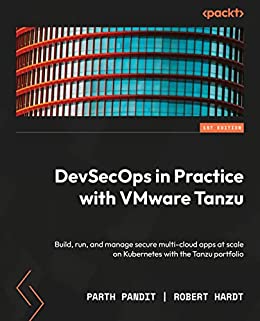Parth Pandit is the author of DevSecOps in Practice with VMware Tanzu; we got the chance to sit down and find out more about his experience of writing with Packt.
Q: What are your specialist tech areas?
Parth: Cloud native applications; container technologies including Kubernetes, Docker and Cloud Foundry; AWS cloud; backend application development using Java technologies
Q: How did you become an author for Packt? Tell us about your journey. What was your motivation for writing this book?
Parth: I have been an active member of LinkedIn for the past 10 years. I have written several blogs and published/circulated them using LinkedIn. Based on my activities and visibility on this professional social networking platform, I was approached by Packt to write the first book on VMware Tanzu. I was working as a Tanzu solution engineer at that time and had a good level of depth in the subject. Becoming a published author has always been my dream and I grabbed this opportunity to chase it. Getting recognized as an SME in the field of Cloud, Kubernetes and Tanzu was the biggest motivation for me to write this book.
Q: What kind of research did you do, and how long did you spend researching before beginning the book?
Parth: As a part of my job profile, I had to work with VMware customers to help them understand the benefits and applications of Tanzu products. I acquired this knowledge on the job working on these products for over 2 years. This deep product understanding across the Tanzu portfolio and the acquired hands-on experience in this year provided me the required foundation to write this book. During the writing process, I had to learn many new concepts that I did not discover before. For that, I took help from other VMware engineers when required.
Q: Did you face any challenges during the writing process? How did you overcome them?
Parth: Completing the book was a yearlong process. This is a big time and I had to deal with many conflicting priorities. Managing time and the meeting chapter submission deadlines were some of the big challenges for me. For that, I had to press very hard and work in stretched hours on several occasions to complete required work.
Q: What’s your take on the technologies discussed in the book? Where do you see these technologies heading in the future?
Parth: Kubernetes is here to stay for a long time as a core application platform. But the industry will see it getting less and less invisible as the focus will shift on better developer productivity. Tanzu Application Platform is a big step in that direction. It hides the complexities of containers, Kubernetes and cloud platforms from developers allowing them to focus on the business logic. In addition to application development, multi-cloud deployment will also be increased in the coming years, where the operators will need more help to streamline application platform operations. Kubernetes is a big answer to manage multi-cloud based containerized applications. But managing Kubernetes on multiple platforms is very difficult. This difficulty of managing diverse Kubernetes platforms is managed by different Tanzu products.
Q: Why should readers choose this book over others already on the market? How would you differentiate your book from its competition?
Parth: This is the first ever book written on Tanzu platform. There is no other book presently available in the market to my knowledge.
Q: What are the key takeaways you want readers to come away with from the book?
Parth: The main idea of the book is to provide an introduction to the Tanzu products at 200 level. The readers can use this book as a learning resource to understand what they can do with different Tanzu products and how to get started with them for a lab-like environment.
Q. What advice would you give to readers learning tech? Do you have any top tips?
Parth: I would advise the readers to understand the benefits, applications and high-level capabilities of different tools and technologies even though they don’t need to use them immediately. Having this knowledge gives them different ideas on what is possible to creatively solve a problem in future. And then learn the applicable tools and the technologies in depth, when it is time to actually develop a production-grade system.
Q. Can you share any blogs, websites and forums to help readers gain a holistic view of the tech they are learning?
Parth: https://tanzu.vmware.com/content/blog/modern-application-development-a-step-by-step-guide
Q. How would you describe your author’s journey with Packt? Would you recommend Packt to aspiring authors?
Parth: It was a good journey. People I worked in Packt are nice and good in what they do. I have had a very pleasant experience working with my Packt’s team.
Q. How did you organize, plan, and prioritize your work and write the book?
Parth: I tried to follow a routine to spend a few hours before sleeping and a few hours in weekends to spend on writing. However, there were several days when I could not do that for other pressing priorities.
Q. What is that one writing tip that you found most crucial and would like to share with aspiring authors?
Parth: Have high-level ideas on what to cover in each chapter before you start writing.
Have a disciplined schedule to write frequently as breaks are difficult to come break from.
Mindful of required page counts and I found it very difficult to stay within the initial estimates of the page counts.
Q. Would you like to share your social handles? If so, please share.
Ashwin: https://www.linkedin.com/in/parthpandit/
You can find Parth’s book on Amazon by following this link: Please click here









